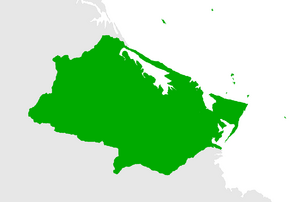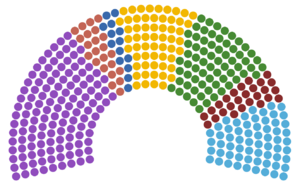Kerussiria: Difference between revisions
| Line 49: | Line 49: | ||
Within Kerusian society, the adept utilization of magic and the arcane is a widely accepted and practised norm. Virtually all individuals possess some degree of magical proficiency, albeit with varying levels of aptitude. One particularly prevalent application of magic is its use in facilitating communication with individuals located at a distance, thus proving beneficial in maintaining contact with loved ones residing afar. Furthermore, it is commonplace for individuals to possess the ability to conjure small pocket dimensions or generate limited quantities of water. These basic spells are commonly taught to children throughout their primary education, with some electing to pursue more advanced magical studies in later years. | Within Kerusian society, the adept utilization of magic and the arcane is a widely accepted and practised norm. Virtually all individuals possess some degree of magical proficiency, albeit with varying levels of aptitude. One particularly prevalent application of magic is its use in facilitating communication with individuals located at a distance, thus proving beneficial in maintaining contact with loved ones residing afar. Furthermore, it is commonplace for individuals to possess the ability to conjure small pocket dimensions or generate limited quantities of water. These basic spells are commonly taught to children throughout their primary education, with some electing to pursue more advanced magical studies in later years. | ||
== Etymology == | == Etymology == | ||
The name "Kerussiria" comes from a romanization of the native name "Ķërusśirri'a", which in | The name "Kerussiria" comes from a romanization of the native name "Ķërusśirri'a", which in Kerushi translates to "Emerald home", with "Ķërus" meaning "emerald" and "śirri'a" meaning "home". Based on a logbook from around 12 AR, originates the first mention of the name where the first major settlement after Reset was first named "Ķërusśirri'a", said city is now known today as Velkaśtäl. | ||
== Geography == | == Geography == | ||
Revision as of 15:47, 16 October 2023
The Republic of Kerussiria | |
|---|---|
| Motto: "Va'kaśtir vix́ härenka um nërin raki, Ṡast ķi'ërassik tärir ki'ro tëķra q́a alķalë!" "Undimmed by cloud or shade of night, Here shone for ever fair and bright!" | |
| Anthem: In My Land Dear | |
 Map of Kerussiria | |
| Capital | Ķëdnśtäl |
| Official languages | Kerushi |
| Recognised national languages | Kerushi, Shibettan |
| Ethnic groups | 68.2% Kerusian 23.2% Shav-eki 8.6% Shibettan |
| Religion | 73.3% No religion 26.7% Ķa'ṡur-Ķi'iț |
| Demonym(s) | Kerusian |
| Government | Parliamentary Republic |
• Ķiver | Belika Na'äkir |
• Prime Minister | Veśen Ag-Óțrall |
| Area | |
• Total | 746,485.46 km2 (288,219.65 sq mi) |
| Population | |
• Estimate | 17,320,000 |
| GDP (nominal) | estimate |
• Total | $1,687,950,000,000 |
• Per capita | $97,456.69 |
| Gini (1611) | low |
| HDI | very high |
| Currency | Ķerel (ĶRL) |
| Date format | dd/mm/yyyy |
| Driving side | right |
| Calling code | +303 |
| ISO 3166 code | VDK |
| Internet TLD | .vdk |
Kerussiria [Kerushi: Ķërusśirri'a], officially the Republic of Kerussiria [Kerushi: Ķërusśirri'a Ituķur], is a semi-isolationist parliamentary republic located on the eastern coast of Pelia with it's closest neighbours Astronia being on it's southern border. The Republic of Kerussiria came to be after the former Premier of the Grand Union of Voidkree, Vera Tuirast, resigned after a series of protests in support of democracy and a more democratic nation. The recent period of history has been the most peaceful period in Kerussiria's history. A population of about 17 million live peacefully spread out across the country with the capital Ķëdnśtäl containing an estimated 2,200,000 people and the second largest city Velkaśtäl having a population of around 1,500,000 people.
Within Kerusian society, the adept utilization of magic and the arcane is a widely accepted and practised norm. Virtually all individuals possess some degree of magical proficiency, albeit with varying levels of aptitude. One particularly prevalent application of magic is its use in facilitating communication with individuals located at a distance, thus proving beneficial in maintaining contact with loved ones residing afar. Furthermore, it is commonplace for individuals to possess the ability to conjure small pocket dimensions or generate limited quantities of water. These basic spells are commonly taught to children throughout their primary education, with some electing to pursue more advanced magical studies in later years.
Etymology
The name "Kerussiria" comes from a romanization of the native name "Ķërusśirri'a", which in Kerushi translates to "Emerald home", with "Ķërus" meaning "emerald" and "śirri'a" meaning "home". Based on a logbook from around 12 AR, originates the first mention of the name where the first major settlement after Reset was first named "Ķërusśirri'a", said city is now known today as Velkaśtäl.
Geography
The geography of Kerussiria is rather simplistic with the west containing grassy woodlands with rocky hills and valleys which then gradually becomes flatter and becomes more tropical filled with small rivers, bogs and wetlands as one heads closer to the coast with the coast being entirely covered in tropical peninsulae, islands and capes. The nation's biggest natural landmark is the Viima Lake, the Viima Spit which separates it from the waters of the Merin Maw and the Mai River.
Administrative divisions
Containing 29 counties, the nation gives a fair amount of devolution to local authorities, which all have their own councils which hold democratic votes on topic pertaining to local laws, new large constructions such as new roads, power generation facilities, schools and etc. The devolution is partly the reason the nation's people are spread across the country as almost every county has its own school system and the basic necessities that people require meaning, individuals do not have to travel far to get an education or medical aid.
Location and borders
Located on the equator on the east coast of Pelia. Its closest neighbours are Nova Solarius to its east across the Magna Sea, Choslow to its north, Kethes to its west and Astronia to its south.
History
Antiquity 50,000-10,000 BR
It is speculated from facts such as the skin colour, complexion and along with artefacts of the Kerusian people, that long ago the Kerusian people most likely inhabited a desert or dry climate before they were shuffled by the Reset. The Kerusian people were most likely a sect of nomadic tribes consisting of other but similar tribes all known as "ķe'ețur" by some artefacts which may have a link to the Voiditen word "ķi'iț" meaning "kinfolk". These ķe'ețur would not make a large and permanent civilization until around 3000 BR. Due to the Reset and the Era of Ruin, small amounts of artefacts remain making further speculation on the topic difficult.
First Civilization 3000-853 BR
From what artefacts and ruins remain the first true civilization that formed was the Ķe'ețur Ķäṡ'ek, a small desert kingdom located in the middle of what was described as a rocky and vast desert known only as "The Death". This kingdom slowly grew through both marrying into and invading it's desert neighbours and subsequently rose to prominence around the year 853 BR where records state that after marrying into a powerful neighbour and forming the Union of Ķäṡ'ek-Turkäl, commonly known today as the First Union of Kerussiria.
1st Union Era 853-403 BR
The Union of Ķäṡ'ek-Turkäl consisted of multiple ķe'ețur which at this time now acted as dynasties had either been diplomatically or forcefully brought into the union. Records from the period state that around this time the Union encompassed several deserts with the population spread across a total of 7 large ķe'ețur and 13 smaller ķe'ețur. The Union throughout the next few centuries waxed and waned in size, its diverse people living their lives in the vast and fortified subterranean cities. The Union was recorded as a superpower in the region and a centre of astronomical knowledge and military might. Though beginning in around year 500 AR, the ancestral tensions between the 20 diverse ķe'ețur would rise, past grudges reignited, mainly between Ķe'ețur Iṡrëķ and Ķe'ețur Kaṡ'amëq́, which, through gaining the support of their fellow ķe'ețur, had split the Union into 3 factions know only through some records as the Neutrals, The Secessionists and The Loyalists. The built-up tension and hatred of a hundred years between these factions would come to its crest in the year 403 BR.
Era of Agony 403-0 BR
The Era of Agony is described as the worst war in the nation's history for the bloodshed and agony caused by it for the next 403 years till the reset. Most information of this era comes from the remains of war relics and ruins.
Deterioration
In the year 403 BR the three factions of Ķe'ețur in the Union government began to prepare for the worst, scheming for how to deal with the imminent civil war for the time for diplomacy had long since passed and civil war was almost certain and it would not end easily. At some point, some of the three factions began to also break into smaller factions due to clashes in ideology and beliefs. Around 9 major factions existed just before the beginning of the Agony Wars.
Agony Wars
The spark to light the flame of the civil war was an armed clash between the Ķe'ețur He'ķan, a member of a Secessionist-aligned coalition and Ķe'ețur Maṡë'iķ, a Loyalist ķe'ețur. After this clash, the Agony Wars began with a total of 13 sub-wars going on in the midst of the civil war between the three original factions. The desert nation quickly began to fall apart even more, its civilians now forming independent warbands and city-states, attempting to endure so that the people of their cities may live a life in relative peace. Only a few Ķe'ețur managed to survive till the end of the Agony Wars and the Ķe'ețur that became Kerussiria, Ķe'ețur Ṡa'aķal had, a century before the end of the conflict, gone into hiding amongst the desert's valleys and canyons. Some ruins state this life was rather nice with a few decades of actual peace, but this would usually be broken up by a small warband discovering the people and attempting to pillage the hidden desert city.
Union records stated before the war that the nation had somewhere near 84 million people living under the Union's banner. Only 16 million remained by the end of the Agony Wars leading to a total supposed death toll of 68 million. Due to the severity of the supposed death toll, after these discoveries in the nation's history were made after the reset, a national holiday, known as the Festival to the Forgotten, was formulated to mourn the millions of nameless innocents who died for petty causes.
2nd Union Era 0-1543 AR
After the Reset, Kerussiria formed as the 2nd Union of Kerussiria. Through the coming centuries, the nation remained generally rather isolationist with it only 600 years after the reset opening its ports to outsiders and even then that was limited with outsiders only allowed a few metres outside the port and most ports being walled off from the rest of any port city. The 2nd Union generally prospered with minor outbreaks of civil disputes generally over rights and freedoms. The largest among them being the Shibettan-Kerusian War which broke out in 651 AR and lasted 39 years. The only time during this era Kerussiria engaged with a foreign nation was during the Triaas Isles Affair.
After those two incidents, the nation enjoyed a relatively sound peace for the next centuries, but after a serious stagnation and general dislike of the one-party government in 1543, along with a series of large protests that swept across the country the government was forced to peacefully resign and allow for an era of true democracy.
Shibettan-Kerusian War
Due to a serious issue of slavery and oppression against Shibettans, the relations between the two sapient species were at an all-time low and on the the 23rd night of Lux the rebellion began in the north.
Triass Isles Affair
During the Shibettan-Kerusian War, the state was too preoccupied with repelling the Shibettan insurrectionists that at the time the islands fell into a period of neglect and resources once meant for its development were routed to the war and the people of the island sought independence so that they could continue to prosper, at this moment the Soritas Dynasty took the opportunity to take the islands in exchange for an end to their neglect. After the Shibettan-Kerusian War had begun to slow down and an end was in sight, naval commanders Ițķën Ag-Tóriķn, Känl Ag-Ṡurrukn Ṯiṡel and Țśnin Ag-Urninó began planning on the retaking of the isles in 688 AR.
Modern Kerussiria 1543-Present AR
Following the peaceful resignation of the government, the Republic of Kerussiria would be formed and would have far greater freedoms than its predecessor though still maintained its hardline on isolationism. Isolationism only came to an end in the year 1599 AR, when the parliament ruled in favour of ceasing the isolation from the outside world and fully opening its borders to the open world, though this decision has been met with some frustration since, it's more staunch and conservative civilians.
Currently, the nation has been expanding its foreign affairs by joining MEU and trading more intensively with its neighbours.
Politics
Government
The government of the Kerussiria is a semi-isolationist parliamentary republic ruled by a prime minister and their chosen government, with the president or locally known as Ķiver as a figurehead meant to pick and instate a prime minister. The parliament or locally the Upper Council, has a total of 841 seats which at maximum 7 of the largest parties seated in the Upper Council with the current ruling party being the Kerusian Centre Reform Party or KCRP. Smaller parties are placed in the Lower Council which is a watered-down version of the Upper Council where the 5 most popular smaller parties converse on topics that if agreed upon are sent to the Upper Council to be discussed.
Foreign Relations
The foreign relations for Kerussiria are lacklustre to say the least as through most of it's history past the Great Shuffle, the nation entered an era of isolationism that has only in recent years started to dissipate. Currently, the foreign relations of Kerussiria involve Choslow and Nova Solarius.
Military
The military of Kerussiria, Armed Forces of Kerussiria or AFKR for short, consists of about 5 main branches; the Kerusian Defence Forces, the Kerusian Air Force, the Kerusian Naval Forces, the Kerusian Steel Guards and the Kerusian Deterrence Task Forces. It contains the highest amount of magic and arcana in the entire country, which it uses to enchant shells, vehicles, weapons or armour in ways technology would have made costly such as imbuing tanks or soldiers to temporarily make them harder to hit by blurring their image or making shells explode into a massive fireball upon impact.
The foremost goal of the AFKR is to ensure that the air, sea and ground are kept clear of unknown foreign crafts and individuals, either escorting them out of the country's borders or escorting them to their destination if they give identification and intent, if not the military is allowed to shoot down or fire warning shots. The other goal is to ensure the safety of the civilian populace which has prompted the AFKR to set up most of their Ground Air Systems around civilian centres and almost every civilian centre near the borders has fortifications in some way or another, be that concrete fortifications with short and long-range AA and AT capabilities to dormant explosives ready to be activated in case of a war.
Economy
The economic structure of Kerussiria is a unique blend of capitalism and a welfare state, nurtured by a combination of liberal and social democratic governments over the years. The nation takes pride in providing its citizens with free public healthcare, which comes at a nominal annual fee of approximately 200 ķerel for individuals over the age of 17. Moreover, the government offers an impressive 46 weeks of paid parental leave, ensuring that parents can take time off work to care for their newborns without worrying about their income.
Natural resources, particularly petroleum production and mining, are the primary sources of income for the Kerussiria government. This approach has allowed the country to maintain a stable economy, providing its citizens with excellent living standards. The unemployment rate is impressively low, standing at 4.8%, and 68% of the population aged between 15-74 are employed. This statistic is a testament to the government's commitment to creating job opportunities for its citizens, ensuring that they can live a quality life.
Demographics
Ethnic groups
In Kerussiria there are a total of 3 main ethnic groups; Kerusian, Shav-ek, Shibettan. Voidian is the largest of the three ethnic groups with 60% of the population being Kerusian.
Voidian
The Kerusian ethnic group holds a substantial majority, comprising approximately 68.2% of the population. This is likely due to the fact that they were the original group that established the nation after the Reset occurred. Interestingly, Kerusians are often characterized by a complexion that closely resembles that of certain desert populations. Moreover, a significant portion of this ethnic group possesses dark brown hair and brown eyes, while a smaller number have green eyes.
Shav-ek
The Shav-eki ethnic group, which constitutes approximately 23.2% of the total population of Kerussiria, is the second largest ethnic group in the country. This group is predominantly located in the western regions of the nation, which are characterized by dense rainforests and other natural features. The Shav-eki are an important part of the cultural and social fabric of Kerussiria, and their contributions to the nation's history and identity are widely recognized and celebrated across parts of Kerussiria.
Shibettan
The Shibettans are the third largest ethnic group, comprising 8.6% of the nation's population. These avian bipeds are primarily found in the northwestern regions of the country and are typically no taller than 100 cm. The Shibettan people have had a tumultuous past within Kerussiria, facing discrimination and even enslavement at times. However, in recent years, strides have been made towards equal rights with the implementation of several laws against the discrimination of non-humans. Despite their troubled history, the Shibettans have persevered and continue to contribute to the diverse cultural fabric of Kerussiria.
Health
Kerussiria, by the constitution, guarantees free, universal health care for all Voidian citizens, through a compulsory state health insurance program. The Ministry of Health of Kerussiria oversees the Kerusian public healthcare system, and the sector employs more than ninety thousand people. Counties also have their own departments of health that oversee local administration.
Kerussiria spent 10.7% of its GDP on Healthcare in 1611. In 1611, the overall life expectancy in Kerussiria at birth was 94.05 years (91.3 years for males and 96.8 years for females), and it had a very low infant mortality rate (5 per 1,000 live births).
Culture
The culture of Kerussiria is a blend of indigenous traditions such as saunas, food and social customs, and more modern values such as egalitarianism, diligence, discipline, and frugality. After the Great Shuffle, Kerussiria became isolated and developed a unique culture with little influence from its neighbours. While the nation's distrust of its neighbours has declined in recent years, there still remains some level of caution, which is why the nation has not sought further cooperation with its neighbours. Recently, Kerussiria has joined the MEU, signalling a willingness to engage with the wider world.
It is noteworthy to observe that despite the prevalence of atheism in the nation, there exists a notable adherence to animism and mythological creatures within Kerusian society. Among the widespread beliefs held by this society is the notion that the stars that reside in the sky serve as both the birthplace and final resting place of all spirits, thus serving as a realm of existence for those who have passed on.





